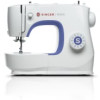Singer M3400 M3400 Stitch Applications Guide - Page 23
Use the Double Overlock Stitch to create
 |
View all Singer M3400 manuals
Add to My Manuals
Save this manual to your list of manuals |
Page 23 highlights
English 92 DOUBLE OVERLOCK STITCH Hemming 93 SLANT OVEREDGE STITCH Seam with Seam Finish 94 SLANT OVEREDGE STITCH Decorative Stitching 95 BARTACK Buttonholes BUTTONHOLE 96 BARTACK Decorative BUTTONHOLE Stitching 97 BARTACK Decorative BUTTONHOLE Eyelets the sewing area. Use a tear-away stabilizer underneath as you sew to help prevent fabric from puckering. Use the Double Overlock Stitch to create sportwear-style hems on stretch knit fabrics. The stitch is flexible and will stretch when the fabric stretches. Turn up the hem allowance and pin the hem in place. Stitch from the top side of the garment, catching the raw edge of the hem on the back side as you sew. Use a polyester or allpurpose thread. Use a Ball Point Needle when sewing stretch fabrics, to prevent skipped stitches. Learn more about needles on the SINGER website. The Slant Overedge Stitch is a stretch stitch, but it can be used on stretch fabrics and non-stretch fabrics (wovens) as well. It sews a seam and a seam finish, all at the same time. Sew the stitch with the left side on the seam line of your project. Trim excess seam allownace when finished sewing. Use this stitch to embellish your sewing projects with a single row, multiple rows, or even in combination with other decorative stitches. Experiment with various types of thread such as rayon thread, all-purpose thread, metallic thread, topstitching thread, or even 30wt and 12wt cotton. Use a needle that is appropriate for the type of thread you are using. It is also helpful to use a stabilizer to help support the stitches. Learn more about needles and stabilizer on the SINGER website. Machine buttonholes are quick and easy to sew. Check your machine manual for details on how to create buttonholes for your specific machine model. Tip: If your machine model doesn't have an automatic tie-off, use a hand sewing needle to bring the thread tails to the back side of your project, then tie them to secure so that the buttonhole stitches don't unravel. Try sewing the buttonhole stitch as a decorative stitch. Sew several on the fabric as desired. Don't cut them open - simply use them as a way to add surface embellishment to your fabric! Use your machine's buttonhole function to create small "eyelets". By making very short buttonholes, you can create openings through which you can weave ribbons or cords, for 23 of 80















